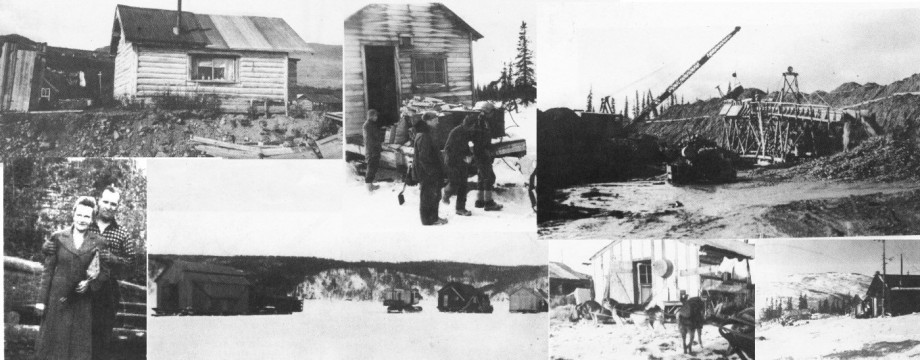Moore Creek Closes
In the fall of 1940, on our way out for the winter, Don Glass of Woodley Airways, from Anchorage, landed us on the very short airstrip in Rainy Pass. Art Woodley came to fly us on into Anchorage, switching planes with Don, who was going back to Flat after another load. Pilots were still being paid on a percentage basis so were scrambling for business.
We had to wait at Rainy Pass for quite a while for Woodley to arrive and it was cold. We built a fire to keep warm.
When we finally got back into the Travelair, Art tried several times to take off. Then he taxied over to the side and asked Don how many turns to take on the trim tab wheel for takeoff. After Don set him straight, he went to the extreme lower end of the short strip that had big spruce trees on each end. This time he was successful but we almost dragged the tops of the trees.
Art wiped his brow and said, “That was too close.”
We decided that because of the numerous days of foggy, rainy weather at Moore Creek, we should have our own airplane so we could get meat and groceries.
In the fall of 1940 I began taking lessons from a friend, Bill Lehtio, an instructor at the Ithaca, New York airport. After eight hours of dual time he let me solo. I built up some time there and at West Palm Beach in Florida and in the fall of 1941 I left Hildur and Ray at Hulda’s and Sulo’s and went back to Lock Haven, Pennsylvania, to finish for my private license and to buy a Piper Super Cruiser.
On December seventh Hildur, Hulda and Sulo came down to see me. I was doing takeoffs and landings, when the instructor waved me to the hangar, telling me that Pearl Harbor had been bombed by the Japanese. The next morning when I went for more flying he said there would be no more civilian training, that it would be all for the Government.
As things turned out, we ran into poor ground and barely made expenses, so abandoned the idea of getting a plane.
Victor Neck, a prospector in Wiseman, a couple of hundred miles north of Fairbanks, wrote that the old man who owned claims on Gold Bench wanted to sell them. Leaving me to manage Moore Creek, Charlie Uotila went to buy the claims, taking Victor in as fifth partner.
We bought the complete mining outfit left near Flat by the Olson brothers when they went to mine platinum at Good News Bay. It included a D-8 and a T-D 40 International bulldozer, a 37-B Bucyrus dragline plus pipe, tools, buildings and all.
Charlie stayed in Flat and hired men to help move the outfit to the river landing in Iditarod, to be shipped by river barges to Stevens Village north of Fairbanks on the Yukon. The rivers froze up before the machinery reached there so some was left at Holy Cross and some at Tanana.
That fall the Government put a closure order on gold mining because fuel and gasoline were being used up and mining was not helping the war effort.
In drilling I found a small rich spot so our last cleanup was a very good one. That was the last of our good ground at Moore Creek.
We all came to Fairbanks wondering what to start doing next. Hildur and I looked around for a place to buy and found a little old log house in the center of town.
The first night in the bedroom we were awakened by water dripping on us from the ceiling. There being no insulation above, the heat caused condensation. We moved the mattress to the living room floor for the rest of the night. The next day I put in lots of insulation but that old house gave us all kinds of problems during the nine years we owned it.
We decided to bring all our D-8 bulldozers to Fairbanks. Victor Neck flew to Ruby with some men and drove the new D-8 that we bought from a miner to Ophir, where they picked up Gus’s and Erick’s D-8.
Charlie Uotila and I went to Flat with some men to fix up Gus’s and John’s D-8 and to build a wanigan (small house on wooden skids) and a shop. At Moore Creek we picked up our D-8. I was on one tractor breaking trail all the four hundred miles About fifty miles from Moore Creek I ran over a stump, cracking the engine oil pan and losing the oil. I welded up the crack.
Near Lake Minchumina a birch tree about one and a half inches thick suddenly came up between the brake pedals, pinning me against the back of the seat by my stomach. I had my hand on the clutch lever and instantly threw it out, backing up to get free. Heavy wool clothes and a thick parka saved me.
Light viscosity fuel oil was unknown yet in those days. When the temperature dropped to thirty degrees below and colder, fuel oil thickened so it was like jelly. I had made sheet iron stoves in Flat to fit the back of the fuel tanks, with a stove pipe extending a little above the cabs. We kept wood fires burning in the stoves, thinning the oil so the transfer pump on the front side of the engine could pump it to the fuel pump.
Every night we put a canvas cover over the engine of each tractor and a coal oil lantern underneath. In the mornings I put a gasoline fire pot under the oil pans for half an hour to start the engines while the others rolled fuel barrels off the sled to lay them on their sides, after first shoveling off the snow for a bare spot. A wood fire on each side of the barrels thinned the fuel enough so it could be pumped into the tanks.
It took us twenty-nine days from Flat to Nenana, about three hundred fifty miles, with the temperature hovering about fifty degrees below zero every day. It was the longest extreme cold spell of all our years in Alaska. Victor and his crew got there three days later.
At Nenana, the Federal Aeronautics Authority gave us a contract to haul four hundred tons of airport building supplies, lumber, fuel oil5 gasoline, black topping oil, etc. forty miles back to Lake Minchumina, where an airport was to be built. We also got a contract from the Federal Communications Commission to haul long spruce poles for radio antenna wires on our way back to Nenana. There were very tall trees around the old Knight’s Road House. John Ogriz took on the job of cooking for the two natives that we hired to cut the poles.
On one return trip we found John alone. He excitedly told us, “I made the finest kind of oyster stew, put lots of butter in it, too. They just looked at it so I fired both of the son-of-a-guns.”
Having only a few more poles to cut to fill the order we did it ourselves.
After this freight haul we drove all the tractors fifty-eight miles into Fairbanks, overhauling them and giving each a new coat of Caterpillar yellow paint.
We rented them all to Bechtel, Price and Calahan, who were starting to build the Canol oil pipeline from Norman Wells in Canada to Fairbanks. Our own drivers operated the bulldozers and I was hired as tractor foreman.
I took mechanics down from Fairbanks in a new Chevrolet pickup that I had for my use to drive to and from the job to check if repairs were needed. To get tracks, track rollers or any parts, I went to the office and got a purchase order for getting the parts from the Northern Commercial Company.
The contract was written so the company had to pay for the fuel, oil, wages and repair parts. The tractors were to be returned to us in as good a condition as when they rented them. I saw to it that this was done.
Later in the summer we contracted to haul freight from Valdez for the same company with our three long flatbed trucks, a Dodge, Ford and an International. We hauled three loads a week, three hundred sixty five miles one way.
After freeze up another contract was given us to cut one hundred cords of wood and fence posts for each of the ten line camps between Fairbanks and the Canadian border. Since the fence posts had to be peeled, we laid them over a long wood fire to thaw, peeling them easily.


